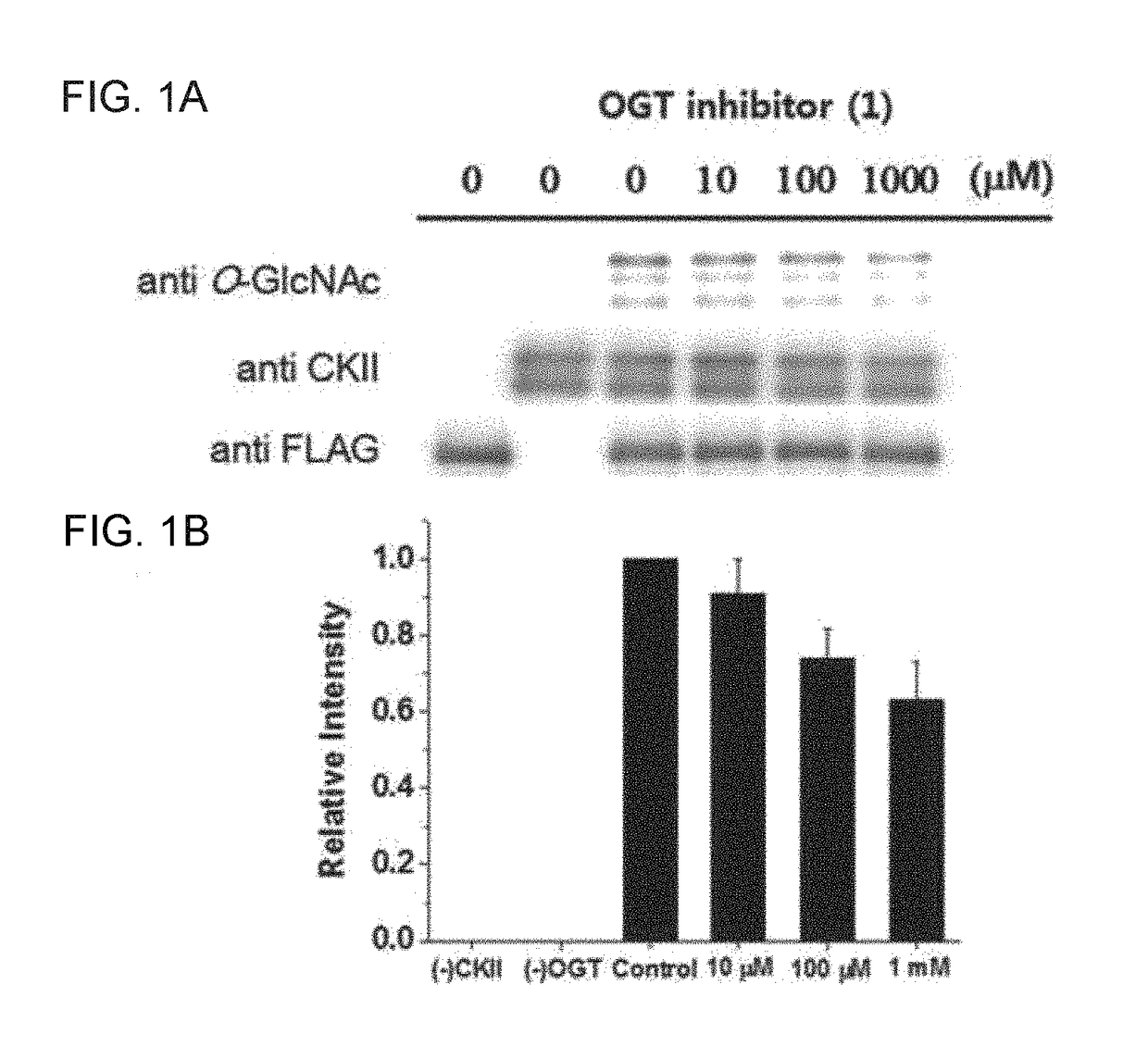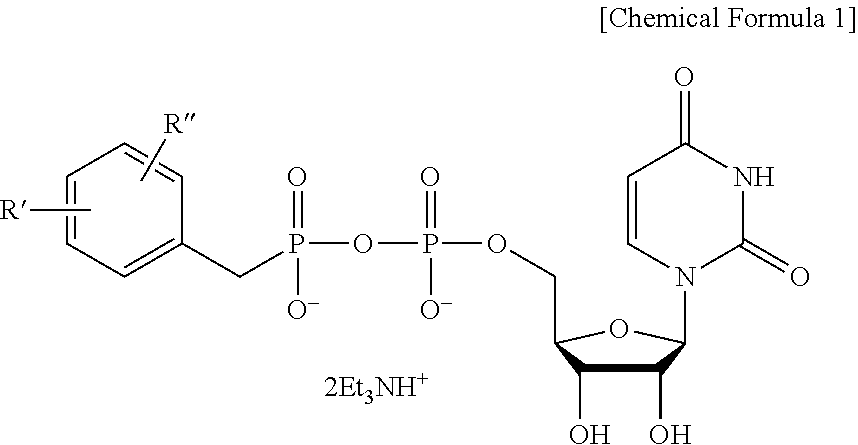C1-phostphonate analogue of UDP-GlcNAc for inhibition of O-GlcNAc transferase
a technology of oglcnac and c1phosphate, which is applied in the direction of sugar derivates, organic chemistry, chemistry apparatus and processes, etc., can solve the problem of no well known substance that displays an inhibitory effect of og
- Summary
- Abstract
- Description
- Claims
- Application Information
AI Technical Summary
Benefits of technology
Problems solved by technology
Method used
Image
Examples
preparation example 1
yl-4-nitrobenzoic acid methylester (3)
[0033]Concentrated sulfuric acid (H2SO4, 97%, 2.66 ml, 48.41 mmol) is added to a solution containing the compound 2 (3-methyl-4-nitrobenzoic acid, 4.53 g, 29.98 mmol) in methanol (MeOH) (25 ml) at the room temperature. After an overnight reflux under agitation, the cloudy reactant mixture becomes clear and then cooled down at the room temperature into a suspension. The precipitate is filled out and washed with cold water. A recrystallization with methanol and a filtration and drying process yields the compound 3 (1.67 g, 37%) as yellowish solid crystals.
[0034]Rf: 0.5 (EtOAc:Hex=1:5); m.p. 79.5-80.0° C.; IR (film, cm−1) 3118 and 3046 (═C—H), 2959 (—C—H), 1732 (C═O), 1585 (Ar), 1520 (N═O), 1429 (Ar), 1344 (N═O); 1H NMR (in CDCl3), 2.63 (s, 3H, CCH3), 3.96 (s, 3H, OCH3), 7.98 (s, 2H), 8.03 (s, 1H) [aromatic protons]; 13C NMR (in CDCl3) 20.30 (CCH3), 52.94 (OCH3), 124.80, 128.28, 133.70, 133.96, 134.23, 152.10 (aromatic carbons), 165.56 (C═O); HR-FA...
preparation example 2
omethyl-4-nitrobenzoic acid methylester (4)
[0035]Benzoyl peroxide (200 mg, 0.83 mmol) and n-bromosuccinimide (1.98 g, 11.14 mmol) are added to a solution containing the compound 3 (1.33 g, 7.43 mmol) dissolved in anhydrous CCl4 (34 ml) at the room temperature. The reactant mixture is subjected to a 16-hour reflux under agitation and then cooled down to the room temperature. The mixture is filtered and washed with hexane. The filtrate is concentrated under vacuum, and the residue is purified by column chromatography to yield a compound 4 (0.98 g, 48%) as a white solid and 3-dibromomethyl-4-nitrobenzoic acid methylester (0.89 g, 34%) as a white solid by-product.
[0036]Rf: 0.4 (EtOAc:Hex=1:10); m.p. 117.0-117.5° C.; IR (film, cm−1) 3124 and 3053 (═C—H), 3002 and 2952 (—C—H), 1722 (C═O), 1586 (Ar), 1529 (N═O), 1442 (Ar), 1356 (N═O), 1277 (CH2—Br, bending), 624 (C—Br); 1H NMR (in CDCl3) 3.99 (s, 3H, OCH3), 4.83 (s, 2H, CH2Br), 8.06 (d, 1H, J=8.43 Hz), 8.13 (dd, 1H, J=8.49 and 1.77 Hz), 8....
preparation example 3
thoxy-phosphorylmethyl)-4-nitrobenzoic acid methylester (5)
[0038]2.40 ml (13.72 mmol) of triethylphosphite is added to a solution containing the compound 4 (0.85 g, 3.11 mmol) in toluene (40 ml) at the room temperature. The reactant mixture is stirred at 115° C. for 28 hours and cooled down to the room temperature. The resultant solution is concentrated under vacuum and distilled at 70° C. The product is purified by column chromatography to yield a compound 5 (0.77 g, 75.10%) as an yellowish oil.
[0039]Rf: 0.5 (EtOAc:Hex=2:1); IR (film, cm−1) 3111 and 3044 (═C—H), 2956 and 2908 (—C—H), 1729 (C═O), 1586 (Ar), 1533 (N═O), 1438 (Ar), 1357 (N═O), 1271 (P═O), 1024 (P-OEt); 1H NMR (in CDCl3) 1.25 (t, 6H, J=7.08 Hz, CH2CH3), 3.72 (d, 2H, J=22.56 Hz, CH2P), 3.97 (s, 3H, OCH3), 3.99-4.10 (m, 4H, OCH2), 7.98 (d, 1H, J=8.49 Hz), 8.06 (ddd, 1H, J=8.49 and 1.98 Hz), 8.13 (dd, 1H, J=2.04 Hz) [aromatic protons]; 31P NMR (in CDCl3) 24.38; HR-FABMS [M+H]+ calcd for C13H19NO7P m / z 332.0899, found 332....
PUM
| Property | Measurement | Unit |
|---|---|---|
| temperature | aaaaa | aaaaa |
| pH | aaaaa | aaaaa |
| pH | aaaaa | aaaaa |
Abstract
Description
Claims
Application Information
 Login to View More
Login to View More - R&D
- Intellectual Property
- Life Sciences
- Materials
- Tech Scout
- Unparalleled Data Quality
- Higher Quality Content
- 60% Fewer Hallucinations
Browse by: Latest US Patents, China's latest patents, Technical Efficacy Thesaurus, Application Domain, Technology Topic, Popular Technical Reports.
© 2025 PatSnap. All rights reserved.Legal|Privacy policy|Modern Slavery Act Transparency Statement|Sitemap|About US| Contact US: help@patsnap.com



